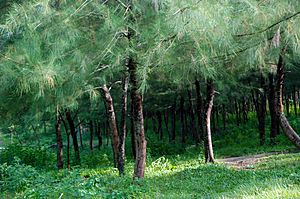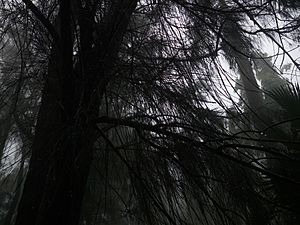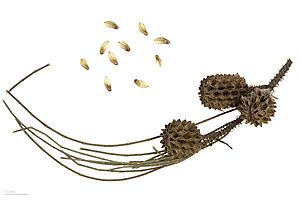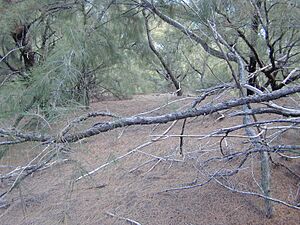Australian pine tree facts for kids
Quick facts for kids Australian pine tree |
|
|---|---|
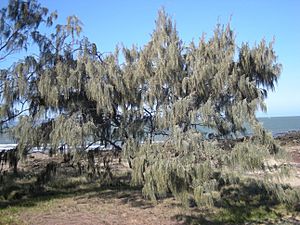 |
|
| C. equisetifolia subsp. incana | |
| Scientific classification | |
| Genus: |
Casuarina
|
| Species: |
equisetifolia
|
| Subspecies | |
|
|
The Casuarina equisetifolia, also known as the Australian pine tree or whistling pine tree, is a type of she-oak from the Casuarina family. It naturally grows across Southeast Asia, Northern Australia, and the Pacific Islands. This includes countries like Thailand, Myanmar, Vietnam, Malaysia, Singapore, Brunei, Indonesia, East Timor, and the Philippines. You can also find it in Papua New Guinea, French Polynesia, New Caledonia, Vanuatu, and parts of Australia. Some trees are also found in Madagascar, but it's not clear if they grew there naturally. This tree has been brought to the Southern United States and West Africa. In some places, like Florida, South Africa, India, and Brazil, it has become an invasive species, meaning it spreads easily and can harm local plants.
Contents
Understanding the Casuarina Tree's Name
The Casuarina equisetifolia was first officially described by Carl Linnaeus in 1759. Its scientific name, equisetifolia, comes from a Latin word meaning "horse hair." This is because its thin, drooping branches look a lot like a horse's tail.
This tree has many common names, depending on where you are. Some of these names include coast sheoak, beach casuarina, beach oak, beach pine, whistling tree, horsetail she oak, Australian pine, ironwood, and Filao tree. In the Philippines, it's called "agoho pine."
There are two main types, or subspecies, of Casuarina equisetifolia:
- Casuarina equisetifolia subsp. equisetifolia: This type grows into a large tree, up to about 35 meters (115 feet) tall. Its twigs are very thin, about 0.5 to 0.7 millimeters wide, and have no hairs. You can find this subspecies in Southeast Asia and northern Australia.
- Casuarina equisetifolia subsp. incana: This type is a smaller tree, usually growing up to 12 meters (39 feet) tall. Its twigs are a bit thicker, about 0.7 to 1 millimeter wide, and are slightly fuzzy. This subspecies is found in eastern Australia, New Caledonia, and southern Vanuatu.
What Does the Casuarina Tree Look Like?
The Casuarina is an evergreen tree, which means it keeps its green leaves all year round. It can grow from 6 to 35 meters (about 20 to 115 feet) tall. Its branches are thin and green to grey-green, like needles. These branches are about 0.5 to 1 millimeter wide. Instead of typical leaves, it has tiny scale-like leaves arranged in groups of 6 to 8.
The tree produces small, catkin-like flowers. The male flowers grow in simple spikes, about 0.7 to 4 centimeters long. The female flowers grow on short stalks. Unlike many other Casuarina species, this tree is monoecious. This means it has both male and female flowers on the same tree.
The fruit of the Casuarina looks like a small, oval, woody cone. It is about 10 to 24 millimeters long and 9 to 13 millimeters wide. Inside, each fruit has many small parts, and each part holds a single seed. The seeds have a small wing, about 6 to 8 millimeters long, which helps them fly away in the wind.
Like some other Casuarina trees, C. equisetifolia is special because it can "fix" nitrogen from the air. This means it can turn nitrogen gas into a form that plants can use to grow. It does this with the help of tiny living things called Frankia actinomycetes, which live in its roots. This process helps to make the soil healthier.
Where the Casuarina Tree Grows
The Casuarina tree is found naturally from Myanmar and Vietnam across Southeast Asia to French Polynesia, New Caledonia, and Vanuatu. It also grows in the northern and eastern parts of Australia, reaching as far south as Laurieton in New South Wales.
How People Use the Casuarina Tree
The Casuarina tree is very popular for bonsai, especially in Southeast Asia and parts of the Caribbean. Bonsai is the art of growing miniature trees in containers. Trees from Indonesia and Taiwan are considered some of the best for bonsai.
The wood from this tree is strong and useful. People use it to make shingles for roofs, fences, and it's known to be excellent firewood because it burns very hot. In Hawaii, Casuarina trees are planted to help stop soil from washing away (erosion) and to act as windbreaks, protecting other plants from strong winds.
There's a famous story from the South Pacific island of Nanumea about a magical spear called Kaumaile. This spear, made from Casuarina wood, was said to have come with a hero named Tefolaha. It was used in battles and passed down through 23 generations. This spear is about 1.80 meters (6 feet) long and is believed to be around 880 years old.
Besides these uses, Casuarina leaves are often used for decoration in cities. Scientists are also studying the Casuarina tree for its potential to help clean up polluted water, especially water from textile dyes. Different parts of the tree, like its leaves, dried cones, bark, and even seeds, have been found to absorb harmful dyes. The carbon made from its cones can also absorb waste from landfills and copper from water.
Traditionally, people have used Casuarina equisetifolia to treat inflammation and other health issues. Recent studies have shown that extracts from its bark and fruit may help with arthritis and have antioxidant properties, which means they can protect cells from damage. Extracts from its leaves have also shown protective effects against certain types of cancer in mice.
Gallery


